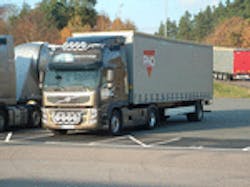GOTHENBURG, SWEDEN. Since the first Volvo truck was produced in Sweden in 1928, the company has focused on producing quality products and service. It is because of this dedication that Volvo has started a global reorganization process of its corporate structure. “Everything we do with this organization is to provide even better service,” said Jenny Bjorsne, head of media relations for Volvo Trucks, at a press event held here this week to showcase the company and its revolutionary I-Shift transmission, which is celebrating 10 years of service in 2011.
Bjorsne pointed out that 2/3 of the Volvo Group business is related to trucks.
“We are a truck group and Volvo trucks are 2/3 of the usiness,” Bjorsne added. She said that the company, which also includes Mack Trucks, Renault Trucks, and UD Trucks, is really focusing on growing its “aftermarket business,” which in its view includes custom financing, used truck and truck rental businesses as well as parts and service.
Volvo offers 2,330 service points around the world, including 620 in North America, and produces seven different kinds of alternative fuel vehicles: biodiesel, synthetic diesel, methane diesel, DME, biogas, hydrogen and biogas, and biogas and biodiesel.
But the real focus of the media event is to showcase its I-Shift, which debuted in Europe in 2001 and in the U.S. in 2007.
“We started the project in 1997, but it really started in the 1980s when a group of young engineers thought about ways to automate a manual transmission,” said Sven-Erik Tibb, manager, drivelines & hybrids.
The I-Shift actually owes its beginnings to the Geartronic transmission, Volvo’s first attempt at an automated manual transmission. The first Geartronic debuted in the early 1990s and was built on a manual transmission. Engineers added a gear shift system and automated clutch control.
Even as Volvo introduced the second generation of the Geartronic in 1999, which included more integration and protection for the valves and electrical components, it was already at work on the I-Shift, which would be built from scratch as an automated mechanical transmission, said Tibb.
The first-generation of the I-Shift, a 24-volt model for Europe, was more advanced than the Geartronic, which never amassed more than a small percentage of sales, in many ways-- offering a more integrated system, higher performance for the transmission ECU due to advanced software development, and more advanced gear selection and gear shift strategies.
In 2006, the company “redesigned” the transmission for higher gross combined weight ratings and higher engine torque.
“We kept the layout on the main box but increased the torque capacities,” said Tibb.
That model was adjusted and turned into a 12-volt, 12-speed transmission for use in the U.S. market, making its debut there in 2007.
But what makes the I-Shift operate so efficiently, said Anders Eriksson, is that “we believe it’s because we see this as an integrated package. It is only available on Volvos.”
“We have in-house development of both the hardware and software, so we know everything there is to know,” he added. “We learned from the Geartronic that … we didn’t have the resources” to properly manage an automated mechanical transmission.
So software engineers added sensors to the gearbox that helps the transmission know every engine characteristic possible to optimize performance. And the software, Eriksson said, is uniquely matched for each engine rating.
The I-Shift sold in the U.S. can be operated in fuel economy mode or performance mode. In performance mode, the system shifts torque to increase power as needed, and when it determines that the power is no longer needed, will automatically shift back to fuel economy mode for optimal operation.
The I-Shift also comes with a host of features. For construction applications, the transmission can include a “rock free” option that will literally rock a vehicle back and forth, creating longer tread paths to assist a vehicle when it becomes stuck.
Customers can also use the power launching option that allows the clutch to release a short burst of extra torque when the vehicle is stuck.
Additional options include the ability to prevent upshifting or downshifting when the driver doesn’t believe it to be necessary.
“The philosophy is the gearbox should do the job without driver intervention, but for some, the driver should still have some control because in the end, the driver still knows best,” said Eriksson.
Fleets can also utilize the transmission’s “eco-roll” function, which conserves fuel by decoupling the engine when the driver lifts his foot off the brake, saving about 30 hp. The engine will return to normal as soon as the throttle, brake pedal, or engine brake is used.
And for fleets that operate in a lot of low-speed conditions, the “idle driving mode” allows the engine to operate at idle speed in any of the lower gear ranges (1-6).
All of the functions noted are available in the U.S., but not for all vehicle applications.
